This article details the subsidy possibilities offered by Hydro-Québec’s Efficient Solutions program for all types of heat pumps found in commercial, industrial, institutional and agricultural buildings. This includes multi-unit dwellings of 20 units or more, which are also eligible under this program. Houses and multi-unit dwellings with 19 units or less are eligible under the Logis Vert program, but are not presented in this article.
What is a heat pump?
A heat pump is a device that transfers heat from one place to another. It can be used to heat or cool a space. In winter, it extracts heat from the outside air (even if it’s cold) and transfers it indoors to heat the space. The heat pump is efficient because it uses the energy present in the outside air rather than creating it, thus reducing energy consumption.
Performance is measured by the COP (coefficient of performance) and can go above 4, meaning that for every 1 kWh of energy consumed, the heat pump can produce 4 kWh of heat. However, the colder it gets, the lower the performance. Efficient heat pumps generally offer a COP above 1.75 at an outdoor temperature of -15°C. It’s also important to understand that a heat pump’s heating capacity is lower the lower the temperature (e.g. a capacity of 12,000 BTU/h at 8.3°C versus a capacity of 9,000 BTU/h at -8.3°C).
Bi-bloc heat pump (mini-split)
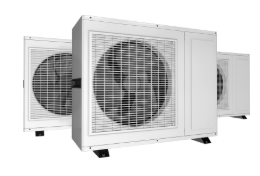
The best-known heat pumps are bi-blocs, also known as mini-splits, which generally include the condenser installed outside and the evaporator installed inside (often a wall-mounted head). These units can be installed in homes, multi-units and commercial buildings.
Subsidies under the Efficient Solutions program have evolved over time. In earlier versions of the program, the subsidy was calculated on the basis of nominal heating capacity at an outdoor temperature of 8.3°C (47°F). Subsidy amounts were generally around $40 per 1000 BTU/h, e.g. $480 for a capacity of 12,000 BTU/h.
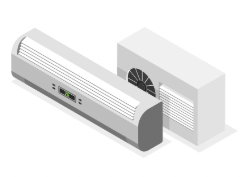 In version 4.1 of the current program, bi-bloc heat pumps are subsidized according to their rated capacity at an outdoor temperature of -8.3°C (17°F). There are also 2 categories: efficient and highly efficient heat pumps. Most heat pumps fall into the efficient category. To be highly efficient, a heat pump must have a maximum capacity at -15°C (5°F) above 70% of the maximum capacity at 8.3°C (47°F). This means that the heat pump will still be able to provide most of its heating capacity when it’s very cold.
In version 4.1 of the current program, bi-bloc heat pumps are subsidized according to their rated capacity at an outdoor temperature of -8.3°C (17°F). There are also 2 categories: efficient and highly efficient heat pumps. Most heat pumps fall into the efficient category. To be highly efficient, a heat pump must have a maximum capacity at -15°C (5°F) above 70% of the maximum capacity at 8.3°C (47°F). This means that the heat pump will still be able to provide most of its heating capacity when it’s very cold.
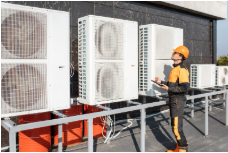 For example, an efficient heat pump rated at 12,000 BTU/h at 47°F could get a subsidy of $350, while a highly efficient heat pump would get $900. In general, the higher subsidy will cover the additional cost of a highly efficient heat pump, making this choice much more attractive. That’s why it’s important to check with us before you buy.
For example, an efficient heat pump rated at 12,000 BTU/h at 47°F could get a subsidy of $350, while a highly efficient heat pump would get $900. In general, the higher subsidy will cover the additional cost of a highly efficient heat pump, making this choice much more attractive. That’s why it’s important to check with us before you buy.
Version 4.1 of the program will be in effect until early 2025. The next 5.1 program may bring significant changes to the subsidies available for bi-bloc heat pumps.
Heat pump rooftop unit
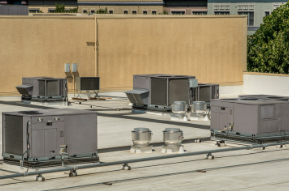 Rooftop units are systems used for commercial, industrial and institutional spaces that generally combine several functions such as air exchange, air conditioning and heating. Most rooftop units do not have heat pump capability, and are instead equipped with an electric coil for air heating. To encourage the adoption of more efficient systems, Hydro-Québec generously subsidizes rooftop heat pumps, especially those with variable-speed compressors. For example, a rooftop with a nominal capacity of 91,500 BTU/h could obtain a $16,000 subsidy when equipped with a variable-speed compressor, versus $2,000 for a constant-speed or stage compressor.
Rooftop units are systems used for commercial, industrial and institutional spaces that generally combine several functions such as air exchange, air conditioning and heating. Most rooftop units do not have heat pump capability, and are instead equipped with an electric coil for air heating. To encourage the adoption of more efficient systems, Hydro-Québec generously subsidizes rooftop heat pumps, especially those with variable-speed compressors. For example, a rooftop with a nominal capacity of 91,500 BTU/h could obtain a $16,000 subsidy when equipped with a variable-speed compressor, versus $2,000 for a constant-speed or stage compressor.
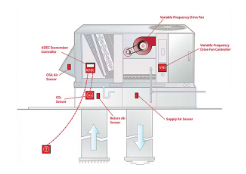 Since the rooftop is also a ventilation and air exchange system, it is possible to obtain an additional subsidy if the fan motor is equipped with an EFV (drive). For example, a rooftop balanced at 3,000 CFM could obtain an additional $560 in subsidy.
Since the rooftop is also a ventilation and air exchange system, it is possible to obtain an additional subsidy if the fan motor is equipped with an EFV (drive). For example, a rooftop balanced at 3,000 CFM could obtain an additional $560 in subsidy.
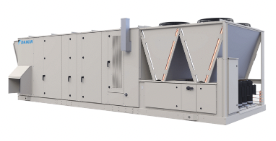 In some high-end roofing units, a heat recovery unit can be added to the air exhaust, giving access to another subsidy. For example, a 3,000 CFM thermal wheel heat recovery unit is eligible for a $7,500 grant. The amount varies according to the efficiency of the system, so if the heat recovery unit is a cassette regenerator, the amount would be $18,600. It’s important to note that the heat recovered must come from an electrically heated space, not a fuel-heated space (for which the grant could be $0).
In some high-end roofing units, a heat recovery unit can be added to the air exhaust, giving access to another subsidy. For example, a 3,000 CFM thermal wheel heat recovery unit is eligible for a $7,500 grant. The amount varies according to the efficiency of the system, so if the heat recovery unit is a cassette regenerator, the amount would be $18,600. It’s important to note that the heat recovered must come from an electrically heated space, not a fuel-heated space (for which the grant could be $0).
VRF heat pumps
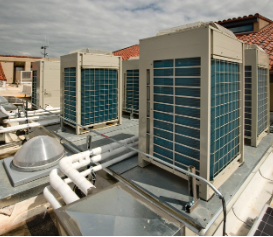 A VRF (Variable Refrigerant Flow) heat pump is an advanced system that enables precise temperature control in different areas of a building. The term VRF stands for Variable Refrigerant Flow, which means that the amount of refrigerant circulating in the system can be adjusted according to the needs of each zone or room. Since these systems are much more efficient and more expensive, subsidies are also much more generous. For example, a system with a nominal capacity of 96,000 BTU/h can obtain a subsidy of $2,800. When the system is fitted with a heat recovery box, the grant is increased to $12,500.
A VRF (Variable Refrigerant Flow) heat pump is an advanced system that enables precise temperature control in different areas of a building. The term VRF stands for Variable Refrigerant Flow, which means that the amount of refrigerant circulating in the system can be adjusted according to the needs of each zone or room. Since these systems are much more efficient and more expensive, subsidies are also much more generous. For example, a system with a nominal capacity of 96,000 BTU/h can obtain a subsidy of $2,800. When the system is fitted with a heat recovery box, the grant is increased to $12,500.
Air-to-water heat pump
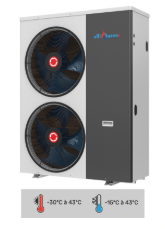 An air-to-water heat pump is a system that extracts heat from the outside air and transfers it to a water system to heat or cool a space. Unlike air-to-air heat pumps, which use ventilation systems to distribute hot or cold air, air-to-water heat pumps use a network of water pipes to heat radiant floors or radiators. Subsidies can reach around $7,500 for a system with a nominal capacity of 64,000 BTU/h.
An air-to-water heat pump is a system that extracts heat from the outside air and transfers it to a water system to heat or cool a space. Unlike air-to-air heat pumps, which use ventilation systems to distribute hot or cold air, air-to-water heat pumps use a network of water pipes to heat radiant floors or radiators. Subsidies can reach around $7,500 for a system with a nominal capacity of 64,000 BTU/h.
Heat pumps for domestic hot water heating
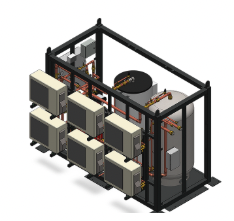 This measure was recently added to the 5.0 program, and is particularly interesting for centralized hot water systems. The heat pump can be used for water preheating or for complete heating. The subsidy is slightly higher for preheating, for example $12,400 for a heat pump with a capacity of 64,000 BTU/h versus $11,400 for full heating.
This measure was recently added to the 5.0 program, and is particularly interesting for centralized hot water systems. The heat pump can be used for water preheating or for complete heating. The subsidy is slightly higher for preheating, for example $12,400 for a heat pump with a capacity of 64,000 BTU/h versus $11,400 for full heating.
Ground-source heat pumps
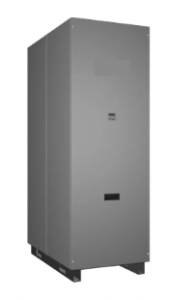 Geothermal heat pumps work in the same way, but have a significant performance advantage: they extract heat from a geothermal well, which is always warmer than the outside air in winter. Of course, this system is much more expensive, which is why subsidies are also much more generous. A geothermal heat pump with a nominal capacity of 64,000 BTU/h would qualify for a subsidy of between $25,000 and $32,500, depending on the type of well.
Geothermal heat pumps work in the same way, but have a significant performance advantage: they extract heat from a geothermal well, which is always warmer than the outside air in winter. Of course, this system is much more expensive, which is why subsidies are also much more generous. A geothermal heat pump with a nominal capacity of 64,000 BTU/h would qualify for a subsidy of between $25,000 and $32,500, depending on the type of well.
We hope you find this information useful in helping your customers make the most of the subsidies available to them. We remain available at all times to assist you with your projects, calculate potential subsidy amounts for your proposals and apply for subsidies for your projects.
